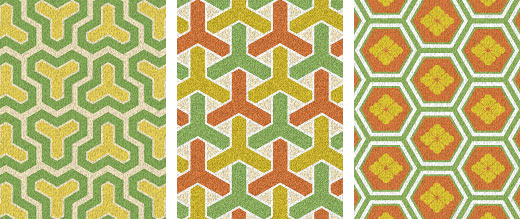|
||
 |
||
 | ||
| *bishamon kikkou 毘沙門亀甲 |
kumikikkou 組亀甲 |
hanairi kikkou 花入亀甲 |
(C)2001 Japanese Architecture and Art Net Users System. No reproduction or republication without written permission.
掲載のテキスト・写真・イラストなど、全てのコンテンツの無断複製・転載を禁じます。
|
||||||
| kikkoumon 亀甲文 | ||||||
| KEY WORD : art history / paintings | ||||||
| Also called bekkougata 鼈甲形. A geometric pattern
comprised of hexagonal units resembling the shape and pattern of a tortoise shell.
Found as a single unit on a family crest, but more common as a repetitive motif
in decorative patterns kikkoutsunagi 亀甲繋. A type of motif based on Heian
Courtly decoration *yuusoku
mon' you 有職文様. Originally a Chinese motif, it was Japanized during the
Heian period and much beloved for its refined, dignified effect and auspicious
connotations of longevity. The pattern was frequently used for court dress, and
later for warriors' kimono 着物 and armor. It also appeared on objects of Buddhist
art, lacquerware, and metalwork. Kikkoumon was sometimes joined with other
motifs, especially the circle motif *marumon
丸文, diamond motif *hishimon
菱文, or broken twig motif oriedamon 折枝文. One variation of the motif is
called *bishamon kikkou 毘沙門亀甲, named after the figure *Bishamonten
毘沙門天, one of the Four Guardian gods *shitennou
四天王, who typically wore armor decorated with a repeat pattern of three hexagonals
jointed to form a Y-shape. Many other variations of the motif were created, such
as; shoukikkou 正亀甲, musubikikkou 結亀甲, *kumikikkou 組亀甲, tsunodashi
kikkou 角出亀甲, yaburekikkou 破亀甲, mitsukikkou 三亀甲, and hanairi
kikkou 花入亀甲. |
||||||
|
||||||
| REFERENCES: | ||||||
| EXTERNAL LINKS: | ||||||
| NOTES: | ||||||
(C)2001 Japanese Architecture and Art Net Users System. No reproduction or republication without written permission. 掲載のテキスト・写真・イラストなど、全てのコンテンツの無断複製・転載を禁じます。 |
||||||